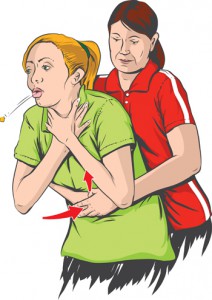
Knowing the correct action to take when someone is choking could mean the difference between life and death. The Heimlich manoeuvre is relatively easy to perform but to make sure it is effective, take a moment to learn the technique and when to use it.
What is the Heimlich manoeuvre?
It is the action of forcing breath from a person’s lungs into his airway to dislodge an object. The idea is to quickly and efficiently force a foreign object out of the body completely so the patient can breath properly again.
When to use the Heimlich manoeuvre
If a person appears to be choking, ask if they need help, and ask if they can speak. If they are able to speak, their airway is not completely blocked and the best course of action is to ask them to cough hard and try to dislodge the object themselves. If they are unable to speak, this is when to use the Heimlich manoeuvre.
How to correctly perform the Heimlich manoeuvre
On an adult – stand behind them and reach around to their stomach, getting them to bend slightly at the same time. Make a fist with one of your hands and place it thumb-side in above the patient’s belly button, but not on their ribs. Place your other hand on top of your fist and sharply apply pressure in and upwards. Try again if the object is not dislodged. Keep performing this until the emergency services arrive.
On a child – you may need to go on your knees to get into the correct position. Do not use the same amount of force, but the action is the same as it is with an adult.
On and infant – care must be taken on a baby under one year old. Find a place to sit and lay the infant on your lap facing downwards. Support the baby’s chest and neck from underneath with one arm, and pat firmly between the shoulders with the other hand. Use the heel of the hand and be firm, but not too hard. The baby’s head should be pointing slightly downward so the object can come out of the mouth easily.
On yourself – Similarly to performing this on another adult, make a fist with one hand, cover it with your other hand and apply quick pressure to the space between your belly button and lowest rib.